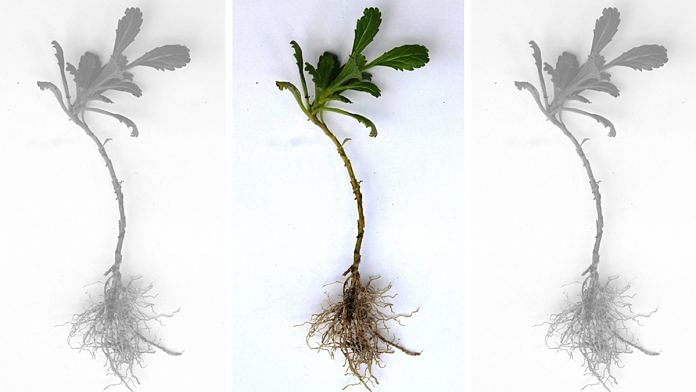New Delhi: Picrorhiza kurroa, also known as kutki in Himachal Pradesh and Uttarakhand, was listed as a rare and endangered herb species in 1997 after it was indiscriminately harvested from the wild due to its medicinal properties.
For many years now, scientists have been trying to grow kutki using tissue culture in the lab, but their attempts have been unsuccessful as the herb dies within a few months of being shifted from the lab to the greenhouse.
Now, a team at CSIR-IHBT has identified a naturally occurring bacteria, which supports the plant’s transition from the lab to the natural environment.
The research revives the country’s hope for restoring the herb in the wild.
“The natural population of the plant is too low. This is an indigenous plant. People just go and harvest the plant from the wild, which is why the plant had to be listed as rare and endangered in 1997,” Sanjay Kumar, director, IHBT told ThePrint.
“These plants are not only commercially important but they are also important for maintaining the ecological cycle, because each plant has its own role,” said Kumar, who is also one of the authors of the peer-reviewed study, published in the journal Genomics.
In Ayurveda, picrorhiza kurroa is used for treatment of digestive disorders and is also said to have a protective effect on the liver. Studies show that it may also improve the immune system.
Also read: Take action against Ayurveda, Unani drugmakers over misleading ads — Modi govt tells states
How the experiment was conducted
Since the plant would die after being shifted to the lab, researchers at IHBT decided to use tissue culture to amplify the number of these plants.
“Essentially, they would be grown in tests tubes or conical flasks in the lab and then planted in the fields,” Sanjay said.
Usually in tissue culture, cuttings from the shoot of the plant is used. But for this plant, the team used the leaves, Amita Bhattacharya, one of the researchers involved in the study, told ThePrint.
“Each leaf was cut into a number of segments out of which thousands of plants could grow,” she said.
“However, whenever we tried to transfer the saplings from the lab to the greenhouse, which is at lower altitude, all of the plants would die within two to three months,” she said.
That is when the team sought help from Rakshak Kumar, a microbiologist at CSIR.
“We went to the natural settings where the plant grows in Lahaul and collected the soil. We then isolated the bacteria from it. We found hundreds of bacteria, we checked which ones have plant growth promoting activity,” Rakshak Kumar told ThePrint.
The idea was to introduce the good bacteria from the natural world into the tissue culture.
The researchers identified a bacteria known as serratia quinivorans PKL:12 which increased the vegetative growth and survival of the plantlets most effectively.
“We did in-pot experiments to check which bacteria is enhancing the growth of the plant,” he said.
“The shoot length was also 2.64 fold higher,” he added.
The study found that as much as 86 per cent of the plantlets survived after 180 days post-treatment with the consortium of bacteria identified by the team, as opposed to 56 per cent when the plant was left untreated.
The team will now distribute the cultured saplings among farmers in Uttarakhand and Himachal Pradesh. They hope that the herb will be revived with their efforts.
(Edited by Neha Mahajan)
Also read: Herbal teas made with sage, perilla leaves suppress SARS-CoV-2 replication, German study finds




Good work. It will be interesting to see the performance of the microbial consortium under real field conditions. Soil ecology plays role, and many microbial additions in the field do not necessarily make significant difference.